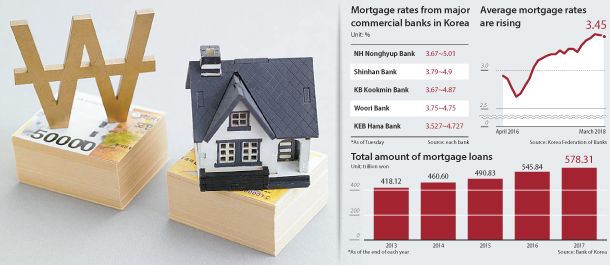Mortgage rates hover around the 5-percent barrier

NH Nonghyup Bank on Tuesday moved up its interest rate range for mixed-rate loans to a range of 3.67 ? 5.01 percent. This was a 0.15-percentage-point jump compared to last month, when the range stood at 3.52 ? 4.86 percent.
For a mixed-rate loan, the interest rate is fixed for five years and adjustable afterwards.
Rates by other major banks also neared the 5 percent mark.
The range for Shinhan Bank was 3.79-4.9 percent, up about 14 basis points compared to a month ago. Woori Bank’s rates rose by 15 basis points during the same period to the 3.75?4.75 range on Tuesday. KEB Hana Bank’s rates on Tuesday were between 3.527 and 4.727, about 15 basis points up from last month. The range set by KB Kookmin Bank was 3.67?4.87 percent on Tuesday.
Interest rates in Korea are determined by cost of the funds index (Cofix) rate and the net interest spreads set by individual banks.
Cofix rates work as a base rate that determines the final interest rate. They are calculated by averaging the interest rates of bank debentures, certificates of deposits, fixed deposits and installment savings by nine major lenders.
While local banks in the past used spreads - which the banks determine autonomously - to increase interest rates, they are pushing down their spreads after the government accused them of profiting from borrowers by manipulating the spreads. KEB Hana Bank, for instance, lowered its spread by 0.16 percentage points last month. But the rise in rates in Korea as well as abroad offsets the falling spreads.
After the U.S. Federal Reserve raised its key rate in March this year by 0.25 percentage points from 1.50 to 1.75 percent, yields on U.S. Treasury bonds have been on the rise. The 10-year bond rate cracked 3 percent for the first time in four years last month. Although the Fed kept the rate steady earlier this month, it’s widely expected that the rate will increase again next month. As a result, key base rates in Korea also have also been growing.
The return on 5-year bank debentures, an important market base rate here, rose to above 2.7 percent from around 2.6 percent last month. The Cofix rate for outstanding balances has been set at 1.78 percent since last month, the highest in the past two years.
With the U.S. Fed poised to increase its base rate again next month, the Bank of Korea is also likely to bump up its own rate soon. That would further push up both adjustable and fixed mortgage rates, market experts say.
“There is no change in the projection that the Fed will raise the rate four times this year,” said Shin Dong-soo, a fixed income analyst at Eugene Investment & Securities. Shin also explained that the dollar has recovered its value recently, which puts a greater burden on the Korean central bank to raise its key rate to prevent foreign capital from escaping the local market.
BY LEE SAENURI, CHOI HYUNG-JO [choi.hyungjo@joongang.co.kr]










with the Korea JoongAng Daily
To write comments, please log in to one of the accounts.
Standards Board Policy (0/250자)